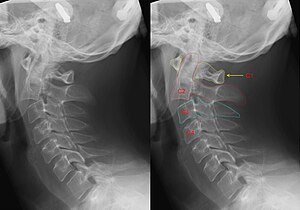Hangman's fracture
| Hangman's fracture | |
|---|---|
 |
|
| X-ray of the cervical spine with a Hangman's fracture. Left without, right with annotation. Clearly can be seen that C2 (red outline) is moved forward with respect to C3 (blue outline). | |
| Classification and external resources | |
| Specialty | emergency medicine |
| ICD-10 | S12.1 |
| ICD-9-CM | 805.02 |
"Hangman's fracture" is the colloquial name given to a fracture of both pedicles or pars interarticularis of the axis vertebra (C2).
The injury mainly occurs from falls, usually in older adults, and motor accidents mainly due to impacts of high force causing extension of the neck and great axial load onto the C2 vertebra. In a study based in Norway, 60 percent of reported cervical fractures came from falls and 21 percent from motor-related accidents. According to the Agency for Healthcare Research and Quality (AHRQ), the group under the highest risk of C2 fractures are elderly people within the age group of 65-84 (39.02 percent) at risks of falls (61 percent) or motor accidents (21 percent) in metropolitan areas (94 percent). 203 discharges were from the age group 1-17; 1843 from 18- to 44-year-olds; 2147 from 45- to 64-year-olds, 4890 from 65- to 84-year-olds, and 3440 from 85+-year-olds. Females accounted for 54.45 percent of occurrences while males accounted for the other 45.38 percent.
The mechanism of the injury is forcible hyperextension of the head, usually with distraction of the neck. Traditionally this would occur during judicial hanging, when the noose was placed below the condemned subject's chin. When the subject was dropped, the head would be forced into hyperextension by the full weight of the body, a sufficient force to cause the fracture. However, despite its long association with judicial hangings, one study of a series of such hangings showed that only a small minority of hangings produced a hangman's fracture.
Apart from hangings, the mechanism of injury—a sudden forceful hyperextension centered just under the chin—occurs mainly with deceleration injuries in which the victim's face or chin strike an unyielding object with the neck in extension. The most common scenario is a frontal motor vehicle accident with an unrestrained passenger or driver, with the person striking the dashboard or windshield with their face or chin. Other scenarios include falls, diving injuries, and collisions between players in contact sports.
...
Wikipedia
